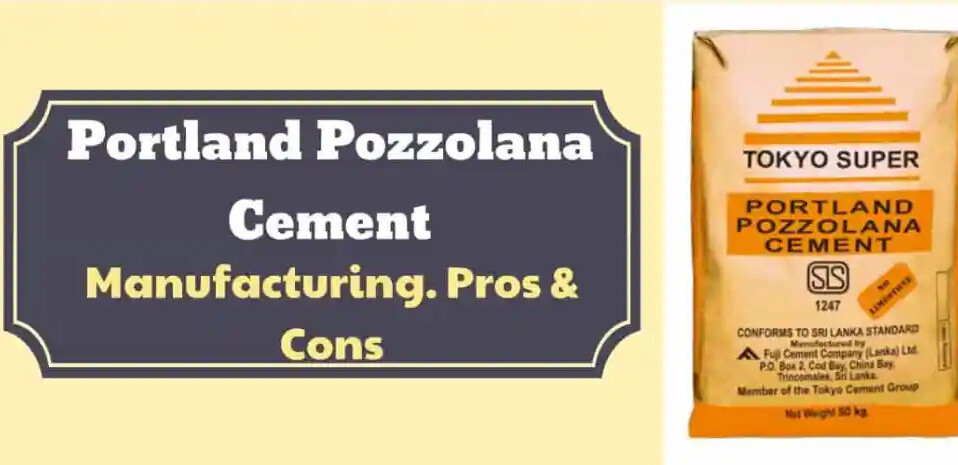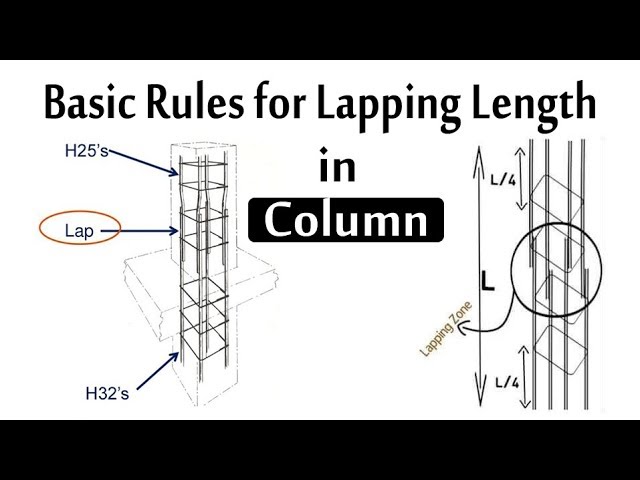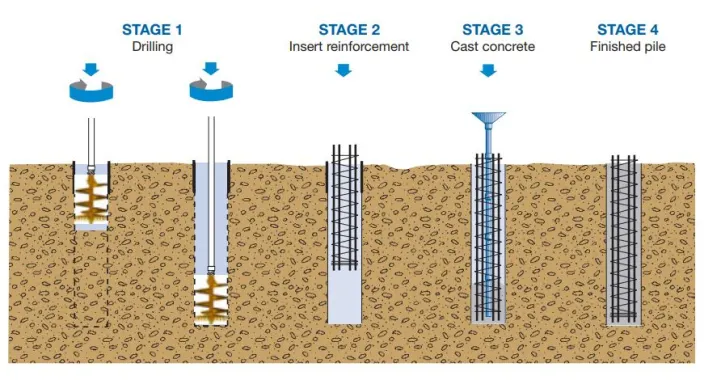Cement has been considered a vital part of the construction. It helps bind the bricks, layout floors, roofs, and walls and is also used in laying our roads. The material is obtained as ash by burning gypsum.
The Romans & Greeks mostly obtained cementing material by burning limestone. They mostly found that tuff and volcanic ash provide concrete when mixed up with limestone. Since then, cement experimented with various things providing superior mortar.
In this article, we will talk about the types of cement used to construct buildings and other things. But, before that, a little overview of cement will help you understand the material better.
An Overview About Cement
Cement is a mixture of chalk, limestone, clay, and marl. However, ordinary cement has been manufactured with two ingredients and heating them into the kiln. Once the mixture is heated, it will be ground into fine powder. Sometimes, cement often confuses concrete but is a combination of concrete ingredients. Concrete is a blend of water, cement, sand aggregates, and stones.
Well, now you know about cement, the next section will talk about the two major categories in which cement is characterized. Check that below!
Also read: Types of Walls Used in Construction
What Are The Primary Characterizations of Cement?
There are two primary characterizations of cement that are around the world. Whatever type of cement, it is divided either into hydraulic or non-hydraulic cement. Characterizations of both these are different and that is what we have discussed below. Have a look!
1. Hydraulic Cement
This is a form of cement that gets harder after adding water or in water. This happens because a chemical reaction takes place between water and cement. The process is known as hydration. The cement type also gets harder underwater.
2. Non-Hydraulic Cement
The cement doesn’t get harder when added to water or underwater. This is known as non-hydraulic cement. It usually gardens when cement reacts with carbon dioxide present in the atmosphere. This cement is highly resistant to chemical attacks once it is set. Moreover, the non-hydraulic cement is made with gypsum, non-hydraulic lime, plaster, and oxychloride.
Types of Cement and its Uses
There are lot many types of cement used in construction but we have tried to cover the most popular ones around the world. Here are different kinds of cement used for construction purposes, which are as follows:
1. Oil Well Cement
This special-purpose cement is used for sealing between a sedimentary rock and steel casing strata by pumping out slurry into the oil well. The cement helps prevent the escaping of gas and oil from the oil well. Above this, the cement is also helpful in preventing surfaces from sulfur gasses and dissolving salts in water. The property is retained in the cement with cellulose and starch products.
At the condition of high temperature and pressure in sealing gas pockets and water pockets as well as repairing & drilling oil wells, hydraulic cement is used. It also contains several retarders to meet the requirement of reducing tricalcium aluminate (C3A) and the coarser grinding content of cement clinker. However, the slurries of such oil-well cement remain pumpable even at high pressure and temperature.
Also Read: Difference between One Way Slab and Two Way Slab
2. Sulfate Resisting Cement
Sulfate-resisting cement is a perfect replacement for ordinary Portland cement, which is prone to sulfate attack. Cement can be an excellent option for constructing buildings on soil infected with sulfates. This sulfate-resisting cement is widely applicable in the areas such as:
- The cement is an excellent choice for the soil infected with sulfate
- The cement is useful for the construction of marine structures, especially in tidal zones
- The cement is excellent for marshy soil areas
- Useful for the construction of sewage treatment plants.
3. Air-Entraining Cement
The air-entraining cement is made by mixing an air-entraining agent in liquid/powder form with Ordinary Portland cement clinker. Various materials are added to the vegetable fats, avid, and animal fat with various wetting agents such as hydrogen peroxide and aluminum powder. The hardened concrete will be increased as you add an air-entraining agent. Segregation, workability, and bleeding properties will improve using this cement.
4. Supersulphated Cement
This form of hydraulic cement has SO3 (Sulphuric anhydride) of less than 5%. It is manufactured by the inter grinding process in which 7% granulated blast furnace slag, Portland clinker, and calcium sulfate are used.
Cement is an excellent option for construction projects, especially in marine areas where water rigorously attacks the surface. Concrete pipelines that are installed underground are made with this cement. Moreover, Supersulphated cement is also an excellent option for constructing bridges and sewage pipes.
5. Extra Rapid Hardening Cement
This cement is a variation of the rapid hardening cement and is manufactured by grinding the calcium chloride along with rapid hardening cement. Ideally, 2% of calcium chloride by weight is mixed with rapid hardening cement. The extra rapid hardening cement should be transported and concrete within 20 minutes after mixing, so mix it properly and transport it faster.
After adding water, rapid hardening cement releases intense heat for a short period, so this will be perfect for use in cold weather.
6. Hydrophobic Cement
The hydrophobic cement is manufactured from ordinary Portland cement by adding some chemicals that repel water during the grinding process. During the manufacturing process, the water repellent coating will be formed on cement particles which prevent the retaining of moisture from the atmosphere.
However, the coating will be broken down when concrete mixes by following the hydration process. Therefore, it is excellent to store for longer and can be kept protected from the wet climate. The hydrophobic agents are stearic acid, oleic acid, naphthenic acid, etc.
7. Rapid Hardening Portland Cement
The cement has been manufactured by mixing argillaceous, alumina, silica, iron oxide, and calcareous. It has the same chemical composition as Portland cement but is finely grounded. It takes 24 hours to set, which is comparatively less than Portland cement.
Hence, you get an advantage of early shuttering removal, which further saves you time. Cement is generally used in the construction of bridges and roads where time is crucial.
8. High Alumina Cement
The High Alumina Cement is obtained by strong grinding of the alumina clinker that consists of monocalcium aluminates. The cement is produced by partial fusion, or complete fusion of the predetermined mixture of lime and alumina, having a minute proportion of silica, iron oxides, and oxides.
This cement shows high durability against all-season and chemical attacks. The color of the cement is black and features rapid hardening because it has a higher amount of aluminate than the calcium silicate present in Portland cement. Rapid heating offers you a significant advantage over fast freezing. However, you can’t use it in hot weather because the porosity will increase, reducing its strength.
9. Ordinary Portland Cement
Cement, also known as basic Portland cement, has been widely used in construction. It offers excellent resistance from cracking and shrinkage dry/ However, it offers no or less resistance to chemical attack. This is why Portland cement is unsuitable for construction in those locations where the soil is rich in sulfates.
The Portland cement is obtained from the incipient fusion of calcium silicate and has a homogenous mixture of 645 lime (CaO), 3-6% alumina, 19-24% silica, and 1-4% iron oxide. The hardening and setting of the cement are due to a reaction between cement and water. These are available in different grades, such as:
- 33-grade cement
- 43-grade cement
- 53-grade cement
10. Portland Slag Cement
The Portland slag cement is a non-metallic product that consists of glass with aluminosilicates and silicates of the lime. The blast furnace slag is produced simultaneously with iron in an electric pig iron furnace. Furthermore, the ground granulated slag is acquired by processing the molten slag through quenching or rapid chilling with steam and air.
Ground granulated blast furnace slag and portable cement clinker are ground together to form the cement. Moreover, permitted additives and gypsum are also added. But the proportion of the furnace slag must be less than 25%, and Portland cement must be 65%. It contains alumina, oxides of lime, and replaced clay. It can be used for a variety of purposes.
11. Quick Setting Cement
Quick setting cement is used for various aggressive foundation areas such as submersible lands, pumping areas, etc. It dries very quickly, and this property is due to the reduction of the Gypsum content from the cement during clinker grinding. Cement is also used in various grouting operations.
12. Expansive Cement
This expansive cement doesn’t show any change in the volume when dried. The cement neither shrinks during drying nor changes its shape after hardening. Expansive cement has been manufactured by using stabilizers and expansive agents.
However, Portland cement and Sulfoaluminate clinker are mixed with a stabilizer. This type of cement is used for the grouting machine, prestressed concrete ducts, and grouting anchor bolts, especially where the volume changes are extremely sensitive.
13. Colored Cement
The cement is highly pigmented and carries the pigment that gives it color. However, the dose of the pigment is only 5-10% in Portland cement. The white/gray cement is mixed with base pigment material to achieve various colors.
14. Masonry Cement
Masonry cement is generally obtained by integrating the mixture of inert material such as limestone with Portland cement clinker. Dolomite, Conglomerates, air-entraining plasticizer, and gypsum will be proportionally suitable. The cement has slow hardening property and ensures high water retentivity, making it perfect for masonry work
15. Sulfate Resisting Cement
Sulfate-resisting cement is a perfect replacement for ordinary Portland cement, which is prone to sulfate attack. Cement can be an excellent option for constructing buildings on soil infected with sulfates. This sulfate-resisting cement is widely applicable in the areas such as:
- The cement is an excellent choice for the soil infected with sulfate
- The cement is useful for the construction of marine structures, especially in tidal zones
- The cement is excellent for marshy soil areas
- Useful for the construction of sewage treatment plants.
16. High Alumina Cement
The High Alumina Cement is obtained by strong grinding of the alumina clinker that consists of monocalcium aluminates. The cement is produced by partial fusion, or complete fusion of the predetermined mixture of lime and alumina, having a minute proportion of silica, iron oxides, and oxides.
This cement shows high durability against all-season and chemical attacks. The color of the cement is black and features rapid hardening because it has a higher amount of aluminate than the calcium silicate present in Portland cement. Rapid heating offers you a significant advantage over fast freezing. However, you can’t use it in hot weather because the porosity will increase, reducing its strength.
17. Quick Setting Cement
Quick setting cement is used for various aggressive foundation areas such as submersible lands, pumping areas, etc. It dries very quickly, and this property is due to the reduction of the Gypsum content from the cement during clinker grinding. Cement is also used in various grouting operations.
18. Supersulphated Cement
This form of hydraulic cement has SO3 (Sulphuric anhydride) of less than 5%. It is manufactured by the inter grinding process in which 7% granulated blast furnace slag, Portland clinker, and calcium sulfate are used.
Cement is an excellent option for construction projects, especially in marine areas where water rigorously attacks the surface. Concrete pipelines that are installed underground are made with this cement. Moreover, Supersuphated cement is also an excellent option for constructing bridges and sewage pipes.
These are all the types of cement that are widely used around the world.
FAQs
What type of cement is more durable for construction?
The concrete that has a lower water-cementitious ratio, i.e., 0.40 or lower is more durable than the ones having a high water-cementitious ratio.
Which one is the most used cement around the world?
Ordinary Portland Cement or OPC is the most used cement around the world. OPC can be used for any type of construction and can be mixed with most construction materials.
What is the shelf life of cement?
The shelf life of cement is around 3-4 months given the fact that it doesn’t come in contact with moisture. Cement can’t be protected if it does come in contact with moisture and it will not be usable. That is the reason, it is crucial to store cement in a place where it doesn’t come in contact with moisture.
Can I use expired cement?
It is not advisable to use cement that is expired because the date is given for health and safety concerns. If you use cement after expiry, there are chances that it can cause allergic diseases because of chromium VI present in the cement.
Final Thoughts on Types of Cement
So, we hope this guide provides you with the basic details about various types of cement used for construction purposes. The basic information helps to know what type of cement works well at the different construction sites. In addition, the guide can be useful for beginner constructors as it helps them get information on the types of cements types.
Stay tuned here for more information and continue reading guides. If you feel there are more types of cement that are used in your region, do let us know in the comments section below.





